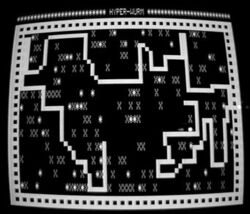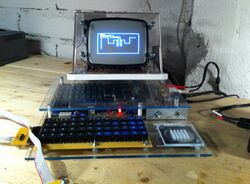Software:Snake (video game genre)

Snake is a sub-genre of action video games where the player maneuvers the end of a growing line, often themed as a snake. The player must keep the snake from colliding with both other obstacles and itself, which gets harder as the snake lengthens. It originated in the 1976 two-player arcade video game Blockade from Gremlin Industries where the goal is to survive longer than the other player. The concept evolved into a single-player variant where a snake gets longer with each piece of food eaten—often apples or eggs. The simplicity and low technical requirements of snake games have resulted in hundreds of versions—some of which have the word snake or worm in the title—for many platforms.
1982's Tron arcade game, based on the film, includes snake gameplay for the single-player Light Cycle segment, and some later snake games borrow the theme. After a version simply called Snake was preloaded on Nokia mobile phones in 1998, there was a resurgence of interest in snake games.
Gameplay

The original Blockade from 1976 and its many clones are two-player games. Viewed from a top-down perspective, each player controls a "snake" with a fixed starting position. The "head" of the snake continually moves forward, unable to stop, growing ever longer. It must be steered left, right, up, and down to avoid hitting walls and the body of either snake. The player who survives the longest wins. Single-player versions are less prevalent and have one or more snakes controlled by the computer, as in the light cycles segment of the 1982 Tron arcade game.
In the most common single-player game, the player's snake is of a certain length, so the tail also moves. Each item "eaten" by the head of the snake causes the snake to get longer. Snake Byte has the snake eating apples. Nibbler has the snake eating abstract objects in a maze.
History


The Snake began with the 1976 arcade video game Blockade[2][3] developed and published by Gremlin.[4] It was cloned as Bigfoot Bonkers the same year. In 1977, Atari, Inc. released two Blockade-inspired titles: the arcade game Dominos and Atari VCS game Surround.[5] Surround was one of the nine Atari VCS launch titles in the US and was sold by Sears under the name Chase. That same year, a similar game was launched for the Bally Astrocade as Checkmate.[6] Mattel released Snafu for the Intellivision console in 1982.
The first known home computer version, Worm, was programmed by Peter Trefonas for the TRS-80 and published by CLOAD magazine in 1978.[2] Versions followed from the same author for the Commodore PET and Apple II. An authorized version of the Hustle arcade game, itself a clone of Blockcade, was published by Milton Bradley for the TI-99/4A in 1980.[7]
The single-player Snake Byte was published in 1982 for Atari 8-bit computers, Apple II, and VIC-20; a snake eats apples to complete a level, growing longer in the process. In Snake for the BBC Micro (1982), by Dave Bresnen, the snake is controlled using the left and right arrow keys relative to the direction it is heading in. The snake increases in speed as it gets longer, and there is only one life.
Nibbler (1982) is a single-player arcade game where the snake fits tightly into a maze, and the gameplay is faster than most snake designs. Another single-player version is part of the 1982 Tron arcade game, themed with light cycles. It reinvigorated the snake concept, and many subsequent games borrowed the light cycle theme.
Starting in 1991, Nibbles was included with MS-DOS for a period of time as a QBasic sample program. In 1992, Rattler Race was released as part of the second Microsoft Entertainment Pack. It adds enemy snakes to the familiar apple-eating gameplay.
Nokia phones

Nokia puts Snake on the majority of their phones:
- Snake – The first published by Nokia, for monochrome phones. It was programmed in 1997 by Taneli Armanto of Nokia[8] and introduced on the Nokia 6110.[9]
- Snake II – Included on monochrome phones such as the Nokia 3310 from 2000.
- Snake Xenzia – Included on later-model monochrome phones (and most cheaper colour phones, such as the Series 30 and Series 30+ budget mobile devices).
- Snake EX – Included on colour phones. First introduced with the Nokia 9290 Communicator in 2002. It supports multiplayer through Bluetooth and Infra-Red.
- Snake EX2 – Introduced with the Nokia 3100 in 2003 and included in several Series 40 handsets.
- Snakes – A 3D version designed for the N-Gage in 2005. It featured multiplayer through Bluetooth. Later Nokia started preinstalling it (without multiplayer) on some Nseries smartphones like N70, N73, N80, etc. It can be downloaded from Nokia support pages and played on any S60 device.[10]
- Snake III – A 3D version, different from Snakes. Snake III takes a more living snake approach, rather than the abstract feel of Snakes. An example of a phone with it installed is the Nokia 3250 from 2005, and it supports multiplayer modes via Bluetooth.
- Snakes Subsonic - Sequel to Snakes, released on May 22, 2008 for N-Gage 2.0.
- Snake (2017) - First released on the Nokia 3310.[11] The Snake game in serveral Nokia phones running Series 30+ and KaiOS such as Nokia 3310, Nokia 8110 4G, Nokia 210 and Nokia 5310 were developed by Gameloft.
- Snake (2017) - Released with Facebook Messenger (2017).
Legacy
In 1996, Next Generation ranked it number 41 on their "Top 100 Games of All Time", citing the need for both quick reactions and forethought. In lieu of a title for a specific version, they listed it as "Snake game" in quotes.[12]
On November 29, 2012, the Museum of Modern Art in New York City announced that the Nokia port of Snake was one of 40 games that the curators wished to add to the museum's collection in the future.[13]
References
- ↑ Tieturi, February 1985. ISSN 0780-9778
- ↑ 2.0 2.1 Gerard Goggin (2010), Global Mobile Media, Taylor & Francis, p. 101, ISBN 978-0-415-46917-3, https://books.google.com/books?id=cellOt5myTsC&pg=PA101, retrieved April 7, 2011
- ↑ Rusel DeMaria & Johnny L. Wilson (2003). High score!: the illustrated history of electronic games (2 ed.). McGraw-Hill Professional. p. 24. ISBN 0-07-223172-6. https://books.google.com/books?id=HJNvZLvpCEQC&pg=PA24. Retrieved April 7, 2011.
- ↑ "Blockade video game, Gremlin Ind, inc. (1976)". Arcade-history.com. April 4, 2008. http://www.arcade-history.com/?n=blockade&page=detail&id=287.
- ↑ Blockade at the Killer List of Videogames
- ↑ Rusel DeMaria & Johnny L. Wilson (2003). High score!: the illustrated history of electronic games (2 ed.). McGraw-Hill Professional. p. 48. ISBN 0-07-223172-6.
- ↑ "Retrogaming Times Monthly 7". My.stratos.net. January 1, 2005. http://my.stratos.net/~hewston95/RTM07/RTM07.html.
- ↑ More, James (January 20, 2009). "History of Nokia part 2: Snake | Nokia Conversations - The official Nokia Blog". Conversations.nokia.com. http://conversations.nokia.com/2009/01/20/history-of-nokia-part-2-snake/.
- ↑ "Taneli Armanto: Snake Creator Receives Special Recognition". Dexigner. https://www.dexigner.com/news/4785.
- ↑ neoncherry (August 12, 2007). "The Unofficial Nokia Gaming Blog: Snakes for S60 Download". http://nokiagaming.blogspot.com/2007/08/snakes-for-s60-3rd-edition-video.html.
- ↑ "Nokia 3310 relaunched today with new version of Snake", Eurogamer.net, 24 May 2017, http://www.eurogamer.net/articles/2017-05-24-classic-nokia-3310-relaunched-today-with-new-version-of-snake, retrieved June 14, 2017
- ↑ "Top 100 Games of All Time". Next Generation (Imagine Media) (21): 55–56. September 1996.
- ↑ "MoMA | Video Games: 14 in the Collection, for Starters". http://www.moma.org/explore/inside_out/2012/11/29/video-games-14-in-the-collection-for-starters/.
External links
 |
